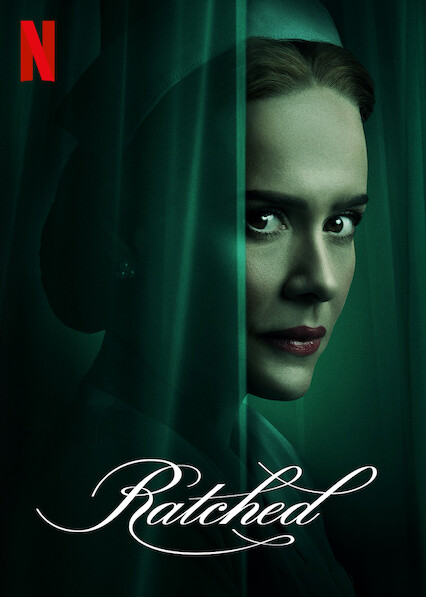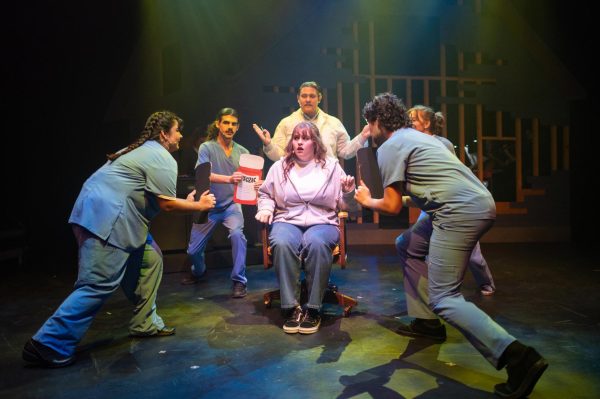Netflix’s “Ratched” is not so wretched

Sarah Paulson is “Nurse Ratched” in Netflix’s new spinoff of “One Flew Over the Cuckoo’s Nest.” Courtesy of Netflix.
The new Netflix original series titled “Ratched” aims to tell the backstory of nurse Mildred Ratched from “One Flew Over the Cuckoo’s Nest” (both the 1962 novel written by Ken Kesey and the 1975 film directed by Milos Forman).
“One Flew Over the Cuckoo’s Nest” was set and filmed in the Oregon State mental hospital in Salem in 1963. “Ratched” is set in Lucia, Calif., and takes place between 1947 and 1950. Lucia is a tiny town just outside of Big Sur, but the Lucia State Hospital where Nurse Ratched works never existed.
“Ratched” was filmed in various locations throughout California. Lucia State Hospital was modeled after the historic Arrowhead Springs Hotel in San Bernardino.
In the film, Mildred is played by Louise Fletcher. In the Netflix series, she is portrayed by Sarah Paulson.
The Mildred we see in “Ratched” is skeptical of the brutal psychiatric treatments carried out at the hospital, such as hydrotherapy, in which patients are locked in tubs of near-boiling water. She also conspires with the equally compassionate orderly Huck (Charlie Carver) to free some of the patients, such as a lesbian couple being treated for homosexuality — which was considered a mental illness at the time.
Shortly after this compassionate act, Mildred begins a relationship with the governor’s press secretary and campaign manager, Gwendolyn Briggs (Cynthia Nixon).
Mildred was an Army nurse during World War II and she asphyxiated dying soldiers who wanted to end their suffering. She is called “an angel of mercy” by several characters throughout the season.
Fast-forward to “Cuckoo’s Nest,” and she is a stern and unyielding authority figure who doesn’t let herself be walked on by the unruly, rebellious patients in a men’s psychiatric ward. Things don’t turn out well for other characters who are more lenient and get taken advantage of.
Right away, this negates Netflix’s attempt to portray their show as a making-of-a-monster prequel, but nonetheless, that’s what it’s billed as. The tagline mentions “a growing darkness” in Mildred’s character, but even in “Cuckoo’s Nest,” she isn’t dark and sinister. Her cruelty scale maxes out at about the level of Lucia’s head nurse, Besty Bucket (Judy Davis), who is impersonal and unquestioningly obedient to the orders of Dr. Hanover (Jon Jon Briones), Lucia’s director.
The components of Mildred’s backstory include childhood abuse and neglect in the foster care system, in which she was united with and then separated from her foster brother, Edmund (Finn Wittrock) after he murdered their abusive foster parents. Mildred got away without being linked to the killings, but Edmund was taken into custody. Mildred and Edmund were reunited decades later when she began working at the hospital in Lucia. She took the job after reading in the newspaper that Edmund had killed four priests (one of them was his biological father) and would be sent to Lucia.
The show is rife with lively characters. Lenore Osgood (Sharon Stone) seeks revenge on Dr. Hanover, who changed her son Henry’s (Brandon Flynn) life forever — for the worst — several years earlier.
Dr. Hanover himself is a compassionate psychiatrist who is somewhat progressive for his time. He believes that many people with mental illnesses can be treated, rehabilitated to live independently and sometimes even cured, rather than spending their lives in and out of mental institutions by default. However, his severe overestimating of some patients’ stability and being too trusting backfires on him more than once.
Gov. Wilburn is up for re-election and doesn’t want to appear as accommodating to criminals, so he adamantly pushes for the execution of Edmund by electric chair rather than lethal injection or gas. This detail is an extreme historical inaccuracy. California has never used electrocution for executions and lethal injection was not used in California until 1996. The only approved method before this was lethal gas.
The show does not play up many stereotypes of mental illness or psychiatric hospitals. With a few huge exceptions, the patients aren’t severely symptomatic or unstable. The mentally ill characters come in three varieties.
There are those who are melancholy enough to cry quietly during regular conversations, but don’t show other signs of depression.
The gay characters aren’t mentally ill, so their only “symptom” is their attraction to the same sex.
The characters with the most severe mental illnesses portrayed on the show turn out to be murderers. For instance, Charlotte Wells (Sophie Okonedo) has multiple personalities and commits a murder that she later has no memory of.
The only in-between of mostly-stable and very-unstable cases of mental illnesses and their symptoms is Mildred’s trauma-induced hallucination and subsequent public outburst during a puppet show she attended with Gwendolyn.
The show balances staying true to the time period the show is set in without using stereotypes of mental illness and psychiatric care. The writers mostly used the names and descriptions of mental disorders as they were understood at the time. Depression is called melancholia, for example. But no one is catatonic or in a straitjacket screaming at things no one else sees, although extreme symptoms such as these were in reality more common at the time due to ineffective treatment.
The humanization of the mentally ill characters is vital to the success of the show. Modern audiences don’t want to see the same tired, outdated “psycho lunatic” portrayals of mental illness that have been prominent in horror and thriller entertainment for decades. For the most part, “Ratched’s” characters are high-functioning and deal with the ebb and flow of their symptoms, which is what many people’s actual experiences are with mental illness today.
Overall, “Ratched” is a riveting psychological thriller worth watching in its own right. The only connection to “Cuckoo’s Nest” is Mildred. None of the other characters from “Ratched” are in “Cuckoo’s Nest” and vice versa. People can watch “Ratched” and enjoy it regardless of whether they see “Cuckoo’s Nest” before, after or not at all.
The film adaptation of “Cuckoo’s Nest” reveals nothing about Mildred’s past or her present life outside of the hospital. The looseness of the connection between the two works basically renders “Ratched” as “Cuckoo’s Nest” fan fiction. This gave the creators of “Ratched” the freedom to mould Mildred’s history in any way they wanted to.
The show plans to shoot four seasons total, with the fourth season leading up to the time of “Cuckoo’s Nest.” Season one has eight episodes that are 45-62 minutes long. Due to coronavirus, it is not clear when season two will be filmed and released.
Rating: 5/10
Kelsey Ogle can be reached at [email protected]








april campbell // Oct 10, 2020 at 5:42 am
I love it, it’s like twilight zone meets american horror story, takes you back to uncertain times! Great especially during Halloween, I cant wait to see the next seasons!!! LOVE its outside of today’s norm.